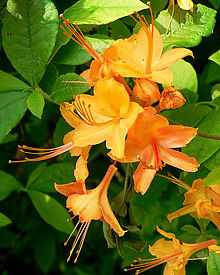Great Balsam Mountains
| Great Balsam Mountains | |
|---|---|
 | |
| Highest point | |
| Peak | Richland Balsam |
| Elevation | 6,410 ft (1,950 m) |
| Coordinates | 35°22′N 82°59′W / 35.367°N 82.983°WCoordinates: 35°22′N 82°59′W / 35.367°N 82.983°W |
| Dimensions | |
| Length | 21 mi (34 km) |
| Width | 18 mi (29 km) |
| Geography | |
| Country | United States |
| State | North Carolina |
| Parent range | Appalachian Mountains |
| Type of rock | gneiss |
The Great Balsam Mountains, or Balsam Mountains, are in the mountain region of western North Carolina, United States.[1][2] The Great Balsams are a subrange of the Blue Ridge Mountains, which in turn are a part of the Appalachian Mountains. The most famous peak in the Great Balsam range is Cold Mountain, which is the centerpiece of author Charles Frazier's bestselling novel Cold Mountain.
The Blue Ridge Parkway runs along its length and at Richland Balsam (milepost 431), the Parkway is at its highest point (6053 feet).
Peaks
- Richland Balsam – 6410 feet
- Black Balsam Knob – 6214 feet
- Mount Hardy – 6120 feet
- Reinhart Knob – 6080 feet
- Grassy Cove Top – 6040 feet
- Tennent Mountain – 6040 feet
- Sam Knob – 6040 feet
- Cold Mountain – 6030 feet
- Shining Rock – 6040 feet
- Chestnut Bald
("Mountain heights". Peakbagger.com.)
Other landmarks
- Balsam Gap
- Devil's Courthouse
- Judaculla Rock (see Tsul 'Kalu; photos[3])
- Tanasee Bald (see Tsul 'Kalu)
Flora
The area consists of a transition forest between the southern Appalachian spruce–fir forest (which resembles forest types found at northern latitudes) and the mixed deciduous forests of temperate America.[4]
Trees
The following trees are at higher elevations:
- Fraser fir[5] ("balsams" or "She balsams"). Forests of these trees appear black from a distance; however, these trees are declining due to the balsam woolly adelgid.[6]
- Red spruce[7] ("He balsams"). The red spruce is distinguished from the Fraser fir by having bark whose rosin cannot be milked (hence, "He balsams") and by having hanging cones.
Shrubs
-

Flame azalea
Sources
- ↑ "Great Balsam Mountains". Geographic Names Information System, U.S. Geological Survey.
- ↑ "Great Balsam Mountains". Peakbagger.com. Retrieved 2007-07-17.
- ↑ "Judaculla". Retrieved 2007-07-19.
- ↑ Sutton, Myron; Sutton, Ann (1985). Eastern forests (Audubon Society Nature Guides). New York: Knopf. ISBN 0-394-73126-3. p43
- ↑ "PLANTS Profile for Abies fraseri (Fraser fir)". USDA PLANTS. Retrieved 2007-07-17.
- ↑ Frankenberg, Dirk (2000). Exploring North Carolina's Natural Areas: Parks, Nature Preserves, and Hiking Trails. Chapel Hill: University of North Carolina Press. ISBN 0-8078-4851-4. p343
- ↑ "PLANTS Profile for Picea rubens (red spruce)". USDA PLANTS. Retrieved 2007-07-17.
- ↑ "PLANTS Profile for Rhododendron calendulaceum (flame azalea)". USDA PLANTS. Retrieved 2007-07-18.

